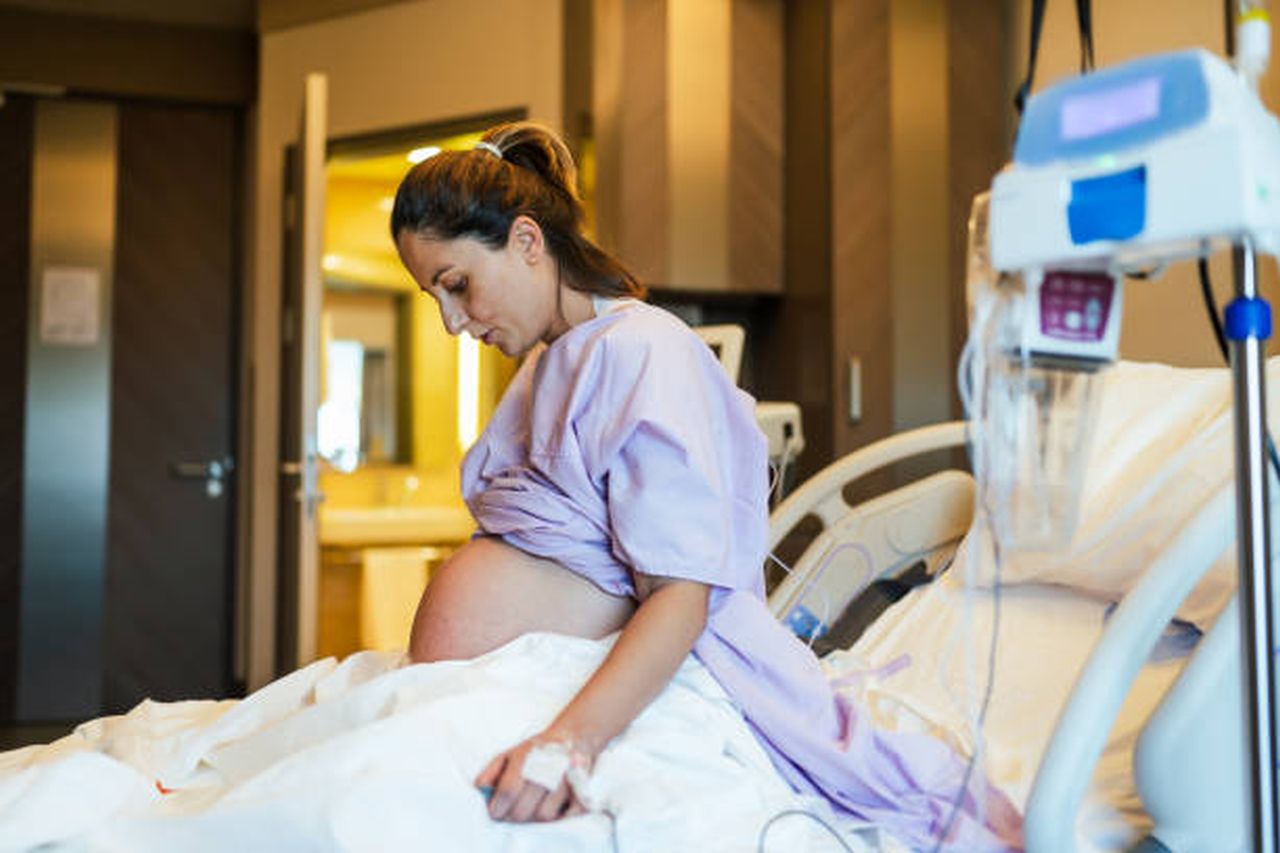A high-risk pregnancy is something to be concerned about.
You're struggling with the physical discomforts of pregnancy, and you're also worried about any issues that could occur.
Birth typically occurs without any intervention. In the case of a normal delivery, the labour process begins on or around the expected date of delivery, and the baby is born healthy.
After a day or two in the hospital, they go home to start their new normal with their growing family. But not all pregnancies go smoothly. Pregnancies with a high risk of complications occur in some women.
Women experiencing what are considered to be high-risk pregnancies need to be aware of the specific threats they face and the measures they can take to protect their health before, during, and after giving birth.
Every single lady hopes to never experience this. Those two little lines on the pregnancy test mean a lot to you, and you couldn't be happier.
You planned your first appointment, but then your OB/GYN delivers the news: you have a high-risk pregnancy.
However, this news does not necessarily guarantee that anything untoward will happen.
If there is a chance that either the mother or the unborn child could be harmed by the pregnancy, then it is termed high-risk.
High-risk pregnancies require supervision by a specialist to help ensure the best outcome for the mother and baby.
In this piece, we'll define high-risk pregnancy and talk about the factors that can increase a woman's risk of developing problems while she's pregnant.
Definition of High-Risk Pregnancy
When a pregnant woman is considered to be "high-risk," it is because she or her baby is at increased risk for complications or premature delivery due to one or more factors.
If a pregnant woman meets any of the following criteria, it is possible that her pregnancy will be categorised as high risk:
- Who is under the age of 17
- Is over the age of 35
- Was either overweight or underweight before becoming pregnant
- Is carrying a multiple pregnancy, whether it be twins, triplets, or more
- Having a medical condition such as high blood pressure, diabetes, depression, etc.
- Had complications during a prior pregnancy, such as labour that lasted longer than expected or the birth of a kid with a genetic disorder or a congenital handicap
- Both the mother and the developing child are vulnerable to the harmful effects of smoking, drug use, and excessive alcohol use.
Come to My Baby Nursery and take a look at our selection of rocking chairs for nurseries.
How Is a Pregnancy Considered High-Risk?
Don't assume the worst just because you've been told you're pregnant with a high-risk baby.
Because of a medical condition or other circumstance, you have an increased risk of having a difficult pregnancy.
Even though high-risk pregnancies are more likely to have negative outcomes, many of these pregnancies end with healthy babies and relieved mothers.
Your doctor has classified you as a high-risk pregnant woman so that you can receive more monitoring and care.
Knowing the dangers will help you stay away from them.

What Are Its Causes?
You can ask your doctor anything you like about high-risk pregnancies, and he or she will gladly explain why your pregnancy is considered high-risk.
Many pregnancies with complications cannot be helped and have nothing to do with the mother. A lot of high-risk pregnancies have unavoidable factors, like:
- Pregnancies in women who are either younger than 17 or older than 35 are classified as high-risk.
- Carrying more than one child during pregnancy
- Having a family history of obstetrical complications (such as premature birth, a previous c-section, miscarriage, or the birth of a child with a congenital handicap)
- Known cases of a genetic disorder in the family
- Suffering from a cardiac ailment
- Epilepsy, renal disease, and polycystic ovarian syndrome are just a few examples.
- Abnormalities in the uterus, cervix, or placenta can cause pregnancy complications.
- Rh sensitization
FAQS About High Risk Pregnancy
The Five Don'ts
- Don't smoke tobacco or nicotine products. First and foremost, don't smoke tobacco products during pregnancy. ...
- Don't consume alcohol. There is no safe amount of alcohol that you could consume during pregnancy. ...
- Don't eat raw meat or deli meat. ...
- Don't sit in hot water. ...
- Don't panic!
Some doctors suggest bed rest for conditions like growth problems in the baby, high blood pressure or preeclampsia, vaginal bleeding from placenta previa or abruption, preterm labor, cervical insufficiency, threatened miscarriage, and other problems.
Stress may lead to high blood pressure during pregnancy. This puts you at risk of a serious high blood pressure condition called preeclampsia, premature birth and having a low-birthweight infant. Stress also may affect how you respond to certain situations.
You will have at least two ultrasounds during your early and middle pregnancy, and in the later parts of your high-risk pregnancy, you may have ultrasounds as often as once a week based on your health needs and situation.
Smoking cigarettes, drinking alcohol and using illegal drugs can put a pregnancy at risk. Maternal health problems. High blood pressure, obesity, diabetes, epilepsy, thyroid disease, heart or blood disorders, poorly controlled asthma, and infections can increase pregnancy risks.
Factors Contributing to a High-Risk Pregnancy
A pregnancy may be deemed high risk if it involves any of the following conditions or factors:
Pregnancy Age
Age of the mother is a major factor in high-risk pregnancies. There is a higher chance of difficulties for women who are younger than 17 or older than 35 when their baby is due. After age 40, a woman's chance of having a miscarriage or a baby born with a problem rises even further.
Pre-existing medical problems that need to be addressed. Pregnancy and infant mortality risk factors include:
- An issue with hypertension
- Problems with breathing, kidneys, or the heart
- Diabetes
- Depression
- Obesity
- Autoimmune disorder
- Sexually transmitted diseases (STDs)
- Infections that persist for an extended period of time (chronic), such the human immunodeficiency virus (HIV) (HIV)
- High-risk pregnancies also include additional risk factors, such as a history of loss, complications during a prior pregnancy, or a family history of genetic diseases.
It is crucial to talk to your doctor if you have a medical condition before deciding to become pregnant.
You and your unborn child's health are important to your doctor, so he or she may order tests, make adjustments to your medication, or suggest other preventative measures.
Pregnancy-related health issues are a special case of this.
It is possible to have a healthy pregnancy regardless of whether or not you have any preexisting conditions.
Common pregnancy complications include:
The hazards to mother and child from preeclampsia, a syndrome characterised by hypertension, increased protein in the urine, and edema, are substantial if treatment is delayed or not initiated.
However, most preeclamptic women go on to have healthy infants if their condition is properly managed.
The origins of preeclampsia are unknown.
Higher risks are associated with factors such as maternal age, excess body weight, and preexisting conditions like hypertension and diabetes. The danger increases if you are carrying more than one baby at a time.
Pregnancy-onset diabetes is called gestational diabetes. If women with gestational diabetes adhere to their healthcare provider's recommended treatment plan, they and their kids may be healthy.
Most cases of diabetes disappear after a woman has given birth. However, women who have had gestational diabetes are more likely to later acquire type 2 diabetes and hypertension.
To avoid harm to the infant, a C-section could be necessary instead of a vaginal delivery.
You are more likely to develop gestational diabetes if you are over the age of 25, pregnant with multiples, overweight, have previously delivered a large infant, or have a history of diabetes in either you or your family.
Depression. Women's rates of depression during pregnancy range from 14 to 23 percent. A history of depression increases your risk for this.
Hormonal shifts, fatigue, domestic stress, and a lack of social support are all factors that have been related to an increased risk of depression during pregnancy.
In turn, depression may contribute to obstetric complications, premature birth, and low birth weight.
It might be challenging to provide for both yourself and your newborn if you are experiencing postpartum depression. Get in touch with your doctor or midwife to discuss the possibility of getting help through talking therapy or medication.
Talk to your pregnant or breastfeeding patient about the pros and cons of using medication.
Obstetrical complications.
It is not uncommon for a pregnancy to be labelled as high risk when complications emerge that have nothing to do with the mother's health. Examples of this are:
When labour begins before 37 weeks, it is considered premature. Premature birth affects around 12% of newborns.
In the long run, premature infants are more likely to experience health issues or lags in development.
In spite of the fact that it is impossible to predict which women will go into labour or give birth prematurely, there are risk factors that can increase a woman's likelihood of having a premature delivery.
Babies are carried in more than one uterus during a multiple birth (twins, triplets, quadruplets, etc.).
Premature labour, gestational diabetes, and pregnancy-induced high blood pressure are all increased in multiple pregnancies, which are more common when women take more infertility therapies.
This population of infants is at a greater risk for developmental delays and cerebral palsy. However, it is important to remember that the vast majority of multiples are born without any major health complications.
When the placenta extends down to cover the cervix, this is known as placenta previa. Having contractions while suffering from this disease greatly increases the risk of bleeding.
A caesarean section may be planned to prevent maternal and infant blood loss if the placenta is still covering the cervix at the time of birth.
Ultrasounds can sometimes detect fetal abnormalities. Between 2% and 3% of infants are born with some sort of structural defect.
Although there may be a history of fetal abnormalities in the family, sometimes they occur for no apparent reason at all.
Even if the reason cannot be changed, the likelihood of complications during pregnancy can be mitigated by adopting a healthy lifestyle. For a more healthy pregnancy:
- Stay at a healthy weight, which means not being underweight (not too much or too little).
- Maintain a balanced diet (getting plenty of fruits, vegetables, whole grains, lean meats, etc.) Do physical activity as prescribed by your physician.
- Make the most of your rest time.
- Reduce your caffeine consumption.
- Stay away from tobacco, alcohol, and narcotics.
- Keep up with the prescribed prenatal treatment.
- Make prenatal medical visits a priority, both in the beginning and later stages of your pregnancy.
- Make sure you take all necessary precautions to avoid getting sick.
- In order to prevent the spread of disease, it is important to practise good hygiene, avoid eating raw meat, seafood, or unpasteurized cheese, acquire the recommended vaccinations, and use condoms.
- Make an effort to live a less stressful existence.
Prenatal Testing for Women at High Risk
A biophysical profile (BPP) may be arranged for women whose pregnancies are considered high-risk.
A healthy pregnancy can be determined with the help of this test. Nonstress testing (NST) and ultrasound exams are combined into one after the 28th week of pregnancy.
A nonstress test (NST) is typically performed to determine the state of the fetus's health.
This is done by attaching a fetal monitor to the mother's belly and analysing the changes in heart rate caused by the baby's movements.
The procedure usually takes between 20 and 30 minutes, and there is no need to spend the night in the hospital.
Nonstress tests have a rather high percentage of false-positive results, meaning they may come back positive when the fetus is healthy, which might lead to an erroneous interpretation. As a result, it's hard to decide what to do next.
By combining a non-stress test with an ultrasound examination, the BPP reduces the likelihood of this happening. It only takes 30 minutes and no hospitalisation is necessary.
Find the perfect finishing touch for your baby's room by browsing our selection of changing table furnishings for the nursery.
There are four aspects to the test that are analysed using ultrasound:
- Amniotic fluid volume
- Fetal tone
- Fetal movements
- Fetal breathing
There is a grading scale from 0 to 2 for each of these and the nonstress test. Maximum possible score is 10.
The BPP score has varying clinical applications. For the most part, a score of 8 or 10 is considered normal, but anything below 8 usually needs further investigation or even delivery.
How Can I Increase My Chances of Having a Healthy Pregnancy?
Maintain a consistent routine whether you anticipate a high-risk pregnancy or wish to take every precaution to avoid one. Such as:

Make a Preconception Consultation Appointment
Talk to your doctor about getting pregnant if you're considering it.
They may recommend that you take a folic acid prenatal vitamin every day and work on your weight before trying to conceive.
In some cases, prenatal care may involve modifying your current treatment plan to accommodate your underlying medical condition.
The likelihood of having a child with a genetic disorder is something your doctor may bring up during your conversation.
Get Prenatal Care on a Routine Basis
The health of both you and the baby can be monitored during prenatal appointments.
Doctors may suggest that you see a specialist in maternal-fetal medicine, genetics, or paediatrics.
Do Not Take Any Chances With Harmful Substances
You should give off smoking immediately. You also can't bring in any booze or narcotics of any kind.
All medications, including those purchased over the counter and those prescribed by your doctor, should be discussed with your doctor.
Should I Get Any Added Tests?
Your doctor's advice will depend on your specific condition and symptoms.
Specific Ultrasound Imaging
This sort of fetal ultrasound, which employs high-frequency sound waves to create images of a baby in the uterus, is performed when an issue, like improper development, is suspected.
Prenatal Cell-Free DNA (CFDNA) Screening
Fetal DNA is checked for the increased risk of specific chromosome disorders by isolating it from the mother's DNA using a blood sample taken during the first trimester.
Invasive Genetic Screening
Medical professionals may suggest amniocentesis or chorionic villus sample (CVS).
Amniocentesis is a procedure in which a little amount of the amniotic fluid, which normally surrounds and protects the developing baby, is removed from the uterus.
Following the 15th week of pregnancy, amniocentesis can detect some genetic disorders and major abnormalities of the brain and spinal cord (neural tube defects).
Placental cells are taken as a sample during CVS. CVS is performed between the tenth and twelfth week of pregnancy and can detect some genetic disorders.
Ultrasound for Cervical Length
At prenatal visits, your doctor may use an ultrasound to examine your cervix and assess the likelihood of premature labour.
Lab Tests
Urine tests for utis and other infectious disease screenings like hiv and syphilis are part of any visit to the doctor.
Biophysical Profile
The purpose of this prenatal ultrasound examination is to ensure the health of the developing baby. Depending on the outcomes of the ultrasound, a foetal heart rate monitor (nonstress test) may not be necessary.
There is a minor risk of miscarriage with some prenatal diagnostic techniques such amniocentesis and chorionic villus sampling.
You and your significant other can make the option to move forwards with these examinations. Talk to your doctor about the potential downsides and upsides.
Preventing and Treating Pregnancy Complications
Many medical professionals advise seeing your doctor before trying to conceive, even if you're in good health now. This is to make sure you're ready to have a healthy baby.
A doctor's appointment is a good time to ask for advice on how to prevent future health issues. Among these are:
- Taking folic acid in doses of at least 400 micrograms daily, beginning at least one month prior to conception and continuing until delivery
- Receiving the Appropriate Vaccinations
- Eating right and staying at a healthy weight
- Unless your doctor advises you differently, you should engage in regular physical activity.
- Keeping away from drugs, alcohol, and smokes (except for medications approved by your doctor)
- Following your doctor's or midwife's approved medication regimen (including prescription and over-the-counter).
- Going to the doctor frequently
- Facilitating their management of conditions like diabetes, depression, high blood pressure, and infection
Your Obstetrician may suggest you see a Perinatologist if your pregnancy is deemed high risk.
A Perinatologist is an obstetrician who has completed further training in the treatment of complicated pregnancies.
To guarantee the safest and healthiest delivery for you and your child, this specialist will collaborate with your primary care physician, midwives, and other medical staff.
Is There Anything More I Should Know About Having a High-Risk Pregnancy?
Talk to your doctor about how your health throughout pregnancy can affect labour and delivery.
Please see a doctor if you experience any of the following:
- Vaginal bleeding or watery vaginal discharge
- Constant, excruciating headaches
- Lower abdominal discomfort, pain, or cramping
- Abnormally low levels of fetal activity
- Discomfort or burning while urinating
- Changes in vision, including blurred vision
- Sudden or severe swelling in the face, hands or fingers
- Chills and fever
- Vomiting or prolonged nausea
- Dizziness
- Thoughts of harming yourself or your baby
There could be highs and lows throughout a high-risk pregnancy. Keeping a positive attitude will help you take the necessary steps towards a successful pregnancy.
What Should I Do If My Pregnancy is Considered High Risk?
If your pregnancy is classified as high-risk, you and your doctor will develop a plan of action to ensure both your health and the health of your unborn child.
Indicators of a high-risk pregnancy that may be addressed by this strategy include:
- The need for more prenatal visits, tests, or ultrasounds
- Seeking the advice of a genetic counsellor
- Involvement of a specialist in maternal and foetal medicine who is familiar with high-risk pregnancies
- A balanced eating regimen
- Guidelines for Risk-Free Physical Activity (or no exercise)
- Smoking cessation help
- Home or hospital bed rest may be necessary in severe situations.
Aside from general signs and symptoms, your doctor may advise you to keep an eye out for things like bleeding, pain, and contractions. Naturally, if you suffer any of these signs, you should immediately see your doctor.
Conclusion
A high-risk pregnancy is something to be concerned about. Pregnancies with a high risk of complications occur in some women. High-risk pregnancies require supervision by a specialist to help ensure the best outcome for the mother and baby. The factors that can increase a woman's risk of developing problems while she's pregnant are discussed below. Knowing the dangers of high-risk pregnancies will help you stay away from them.
A pregnancy may be deemed high risk if it involves any of the following conditions or factors. Pregnancy and infant mortality risk factors include hypertension, diabetes, depression, Obesity, autoimmune disorder, and sexually transmitted diseases (ST). It is possible to have a healthy pregnancy regardless of whether or not you have any preexisting conditions. Preeclampsia, a syndrome characterised by hypertension, increased protein in the urine, and edoema, can be serious if treatment is delayed or not initiated. Women who have had gestational diabetes are more likely to later acquire type 2 diabetes and hypertension.
Postpartum depression may contribute to premature birth and low birth weight. Premature labour, gestational diabetes, and pregnancy-induced high blood pressure are all increased in multiple pregnancies. A caesarean section may be planned to prevent maternal and infant blood loss if the placenta is still covering the cervix at the time of birth. Between 2% and 3% of infants are born with some sort of structural defect. Nonstress tests have a rather high percentage of false-positive results, meaning they may come back positive when the fetus is healthy.
By combining a nonstress test with an ultrasound examination, the BPP reduces the likelihood of this happening. The BPP involves attaching a fetal monitor to the mother's belly and analysing the changes in heart rate caused by the baby's movements. The purpose of a prenatal ultrasound examination is to ensure the health of the developing baby. There is a minor risk of miscarriage with some prenatal diagnostic techniques such as amniocentesis and chorionic villus sampling. Many medical professionals advise seeing your doctor before trying to conceive, even if you're in good health now.
If your pregnancy is considered high-risk, you and your doctor will develop a plan of action to ensure both your health and the health of your unborn child. Keeping a positive attitude will help you take the necessary steps towards a successful pregnancy. Follow your doctor's or midwife's approved medication regimen (including prescription and over-the-counter) for managing conditions like diabetes, depression and high blood pressure.
Content Summary
- A high-risk pregnancy is something to be concerned about.
- You're struggling with the physical discomforts of pregnancy, and you're also worried about any issues that could occur.
- Pregnancies with a high risk of complications occur in some women.
- Women experiencing what are considered to be high-risk pregnancies need to be aware of the specific threats they face and the measures they can take to protect their health before, during, and after giving birth.
- If there is a chance that either the mother or the unborn child could be harmed by the pregnancy, then it is termed high-risk.
- High-risk pregnancies require supervision by a specialist to help ensure the best outcome for the mother and baby.
- In this piece, we'll define high-risk pregnancy and talk about the factors that can increase a woman's risk of developing problems while she's pregnant.
- When a pregnant woman is considered to be "high-risk," it is because she or her baby is at increased risk for complications or premature delivery due to one or more factors.
- Had complications during a prior pregnancy, such as labour that lasted longer than expected or the birth of a kid with a genetic disorder or a congenital handicap
- Both the mother and the developing child are vulnerable to the harmful effects of smoking, drug use, and excessive alcohol use.
- Don't assume the worst just because you've been told you're pregnant with a high-risk baby.
- Because of a medical condition or other circumstance, you have an increased risk of having a difficult pregnancy.
- Even though high-risk pregnancies are more likely to have negative outcomes, many of these pregnancies end with healthy babies and relieved mothers.
- Your doctor has classified you as a high-risk pregnant woman so that you can receive more monitoring and care.
Knowing the dangers will help you stay away from them. - You can ask your doctor anything you like about high-risk pregnancies, and he or she will gladly explain why your pregnancy is considered high-risk.
- Many pregnancies with complications cannot be helped and have nothing to do with the mother.
- A lot of high-risk pregnancies have unavoidable factors, like: Pregnancies in women who are either younger than 17 or older than 35 are classified as high-risk.
- Abnormalities in the uterus, cervix, or placenta can cause pregnancy complications.
- A pregnancy may be deemed high risk if it involves any of the following conditions or factors:
- Age of the mother is a major factor in high-risk pregnancies.
- Pregnancy-related health issues are a special case of this.
- It is possible to have a healthy pregnancy regardless of whether or not you have any preexisting conditions.
- The origins of preeclampsia are unknown.
- Pregnancy-onset diabetes is called gestational diabetes.
- You are more likely to develop gestational diabetes if you are over the age of 25, pregnant with multiples, overweight, have previously delivered a large infant, or have a history of diabetes in either you or your family.
- Depression.
- Women's rates of depression during pregnancy range from 14 to 23 percent.
- A history of depression increases your risk for this.
- Hormonal shifts, fatigue, domestic stress, and a lack of social support are all factors that have been related to an increased risk of depression during pregnancy.
- It might be challenging to provide for both yourself and your newborn if you are experiencing postpartum depression.
- Get in touch with your doctor or midwife to discuss the possibility of getting help through talking therapy or medication.
- In the long run, premature infants are more likely to experience health issues or lags in development.
- In spite of the fact that it is impossible to predict which women will go into labour or give birth prematurely, there are risk factors that can increase a woman's likelihood of having a premature delivery.
- This population of infants is at a greater risk for developmental delays and cerebral palsy.
- However, it is important to remember that the vast majority of multiples are born without any major health complications.
- Having contractions while suffering from this disease greatly increases the risk of bleeding.
- Even if the reason cannot be changed, the likelihood of complications during pregnancy can be mitigated by adopting a healthy lifestyle.
- For a more healthy pregnancy:
- Stay at a healthy weight, which means not being underweight (not too much or too little).
- Make the most of your rest time.
- Keep up with the prescribed prenatal treatment.
- Make prenatal medical visits a priority, both in the beginning and later stages of your pregnancy.
- Make sure you take all necessary precautions to avoid getting sick.
- In order to prevent the spread of disease, it is important to practise good hygiene, avoid eating raw meat, seafood, or unpasteurized cheese, acquire the recommended vaccinations, and use condoms.
- Nonstress testing (NST) and ultrasound exams are combined into one after the 28th week of pregnancy.
- A nonstress test (NST) is typically performed to determine the state of the fetus's health.
- By combining a non-stress test with an ultrasound examination, the BPP reduces the likelihood of this happening.
- Maintain a consistent routine whether you anticipate a high-risk pregnancy or wish to take every precaution to avoid one.
- Talk to your doctor about getting pregnant if you're considering it.
- The likelihood of having a child with a genetic disorder is something your doctor may bring up during your conversation.
- Your doctor's advice will depend on your specific condition and symptoms.
- Invasive Genetic Screening.
- Medical professionals may suggest amniocentesis or chorionic villus sample (CVS).
- At prenatal visits, your doctor may use an ultrasound to examine your cervix and assess the likelihood of premature labour.
- Urine tests for utis and other infectious disease screenings like hiv and syphilis are part of any visit to the doctor.
- The purpose of this prenatal ultrasound examination is to ensure the health of the developing baby.
- Depending on the outcomes of the ultrasound, a foetal heart rate monitor (nonstress test) may not be necessary.
- There is a minor risk of miscarriage with some prenatal diagnostic techniques such amniocentesis and chorionic villus sampling.
- Talk to your doctor about the potential downsides and upsides.
- Many medical professionals advise seeing your doctor before trying to conceive, even if you're in good health now.
- Following your doctor's or midwife's approved medication regimen (including prescription and over-the-counter).
- Your Obstetrician may suggest you see a Perinatologist if your pregnancy is deemed high risk.
- A Perinatologist is an obstetrician who has completed further training in the treatment of complicated pregnancies.
- Talk to your doctor about how your health throughout pregnancy can affect labour and delivery.
- Keeping a positive attitude will help you take the necessary steps towards a successful pregnancy.
- If your pregnancy is classified as high-risk, you and your doctor will develop a plan of action to ensure both your health and the health of your unborn child.
- Aside from general signs and symptoms, your doctor may advise you to keep an eye out for things like bleeding, pain, and contractions.
- Naturally, if you suffer any of these signs, you should immediately see your doctor.






